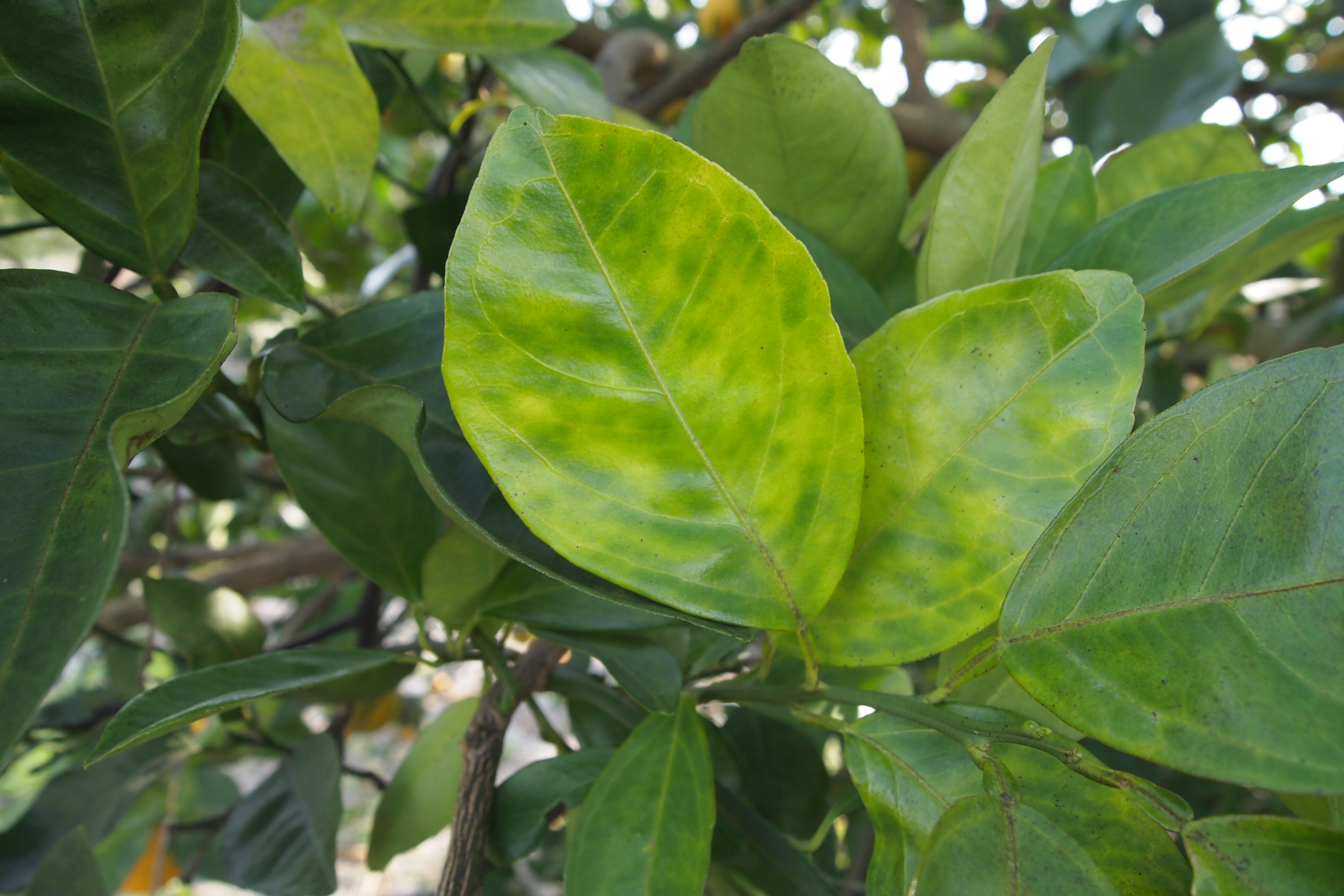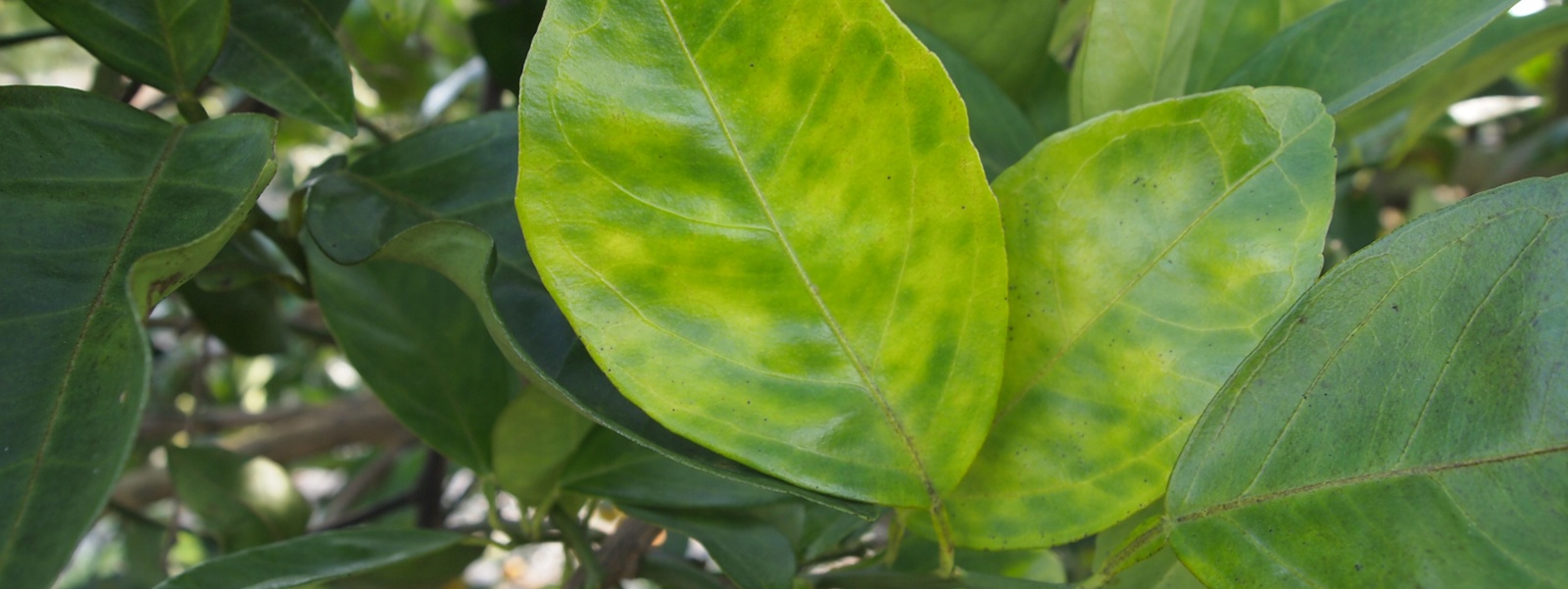Ventura County latest to establish HLB quarantine

- In this file photo, huanglongbing-infected citrus tree leaves from a residential citrus tree show symptoms including blotchy, yellowing of leaves and yellow shoots.
- Photo/Citrus Pest and Disease Prevention Program.

By Ching Lee
A new quarantine has been established in Ventura County, a key commercial citrus-growing region, after two residential citrus trees in the city of Santa Paula tested positive for the fatal citrus disease huanglongbing, or citrus greening.
The quarantine, which covers a minimum 5-mile radius around where the diseased trees were found, is mandated by law to restrict movement of citrus fruit, trees and related plant material, so as not to artificially spread the disease. State officials said they may expand the quarantine area if more infected trees are found.
As of Oct. 6, 11 more trees in Santa Paula had tested positive for the disease, bringing the total to 13.
Moving citrus nursery stock, host plants or plant parts out of the quarantine area is prohibited, though special provisions are given to commercial growers and packers to allow them to move fruit if they have taken steps to mitigate risk. Quarantine requirements affect them differently depending on their location and where their fruit is going.
In a meeting last week at Farm Bureau of Ventura County, Keith Okasaki, regulatory manager for the California Department of Food and Agriculture Citrus Pest and Disease Prevention Division, said the state tries to minimize the size of the quarantine to reduce impact on growers and the industry.
The quarantine area is “never going to be a perfect circle,” he said, as it follows physical mapping features visible in the field, such as roads, highways, rivers, railroad tracks and various boundary lines to meet legal requirements. That means farms on one side of the road may fall within the quarantine zone while a neighboring farm may be outside of it.
“We do the best we can to exclude as many people as possible,” Okasaki said. “If you happen to be within the 5 miles, unfortunately, you’re going to be quarantined.”
CDFA confirmed the first two infected trees—one orange and one lime, both found on one residential property—on Sept. 27. They represent the first in the county to have tested positive for huanglongbing, or HLB. The discovery follows confirmation on Sept. 19 of an Asian citrus psyllid that tested positive for Candidatus Liberibacter asiastius, the pathogen associated with HLB.
HLB is considered the most severe bacterial disease of citrus. All commonly grown citrus varieties are susceptible. The Asian citrus psyllid can transmit the disease as it feeds on citrus plants. Infected trees produce bitter and misshaped fruit and die within a few years. There is no known cure. The only way to protect citrus trees from the disease is to prevent spread of the HLB pathogen by controlling populations of the psyllid and destroying infected trees.
Since its discovery in Florida in 2005, HLB has wreaked havoc on that state’s citrus production, which has dropped by 90%, according to the U.S. Department of Agriculture.
As part of the response to the HLB findings, CDFA is scheduled to remove the infected trees. The state is also mandated to survey and treat every property within 250 meters of the detection site. As of Oct. 2, 177 of 280 properties had been surveyed, Okasaki said. Treatment with the insecticides Merit 2F and Tempo SC Ultra started on Oct. 9.
To date, the disease has not shown up in any commercial citrus orchards in California, though the psyllid is well established in Southern California and Ventura and Santa Barbara counties. In addition to Ventura County, HLB quarantines remain in effect in parts of Los Angeles, Orange, Riverside, San Bernardino and San Diego counties, where more than 6,481 trees have tested positive for the disease as of Oct. 6, according to CDFA. In total, the quarantine boundaries cover 2,127 square miles.
The Ventura County quarantine area is significant because it includes about 8,600 acres of commercial citrus. That’s roughly four times the cumulative commercial acreage under HLB quarantine in other parts of the state, CDFA said in an email to Ag Alert®. Ventura County remains the state’s top producer of lemons.
The department said there are no commercial citrus groves or packinghouses in the 250-meter radius around the initial detection site. However, CDFA said the city of Santa Paula, where the detections were confirmed, is surrounded by citrus and avocado orchards that line the Santa Clara River Valley.
In addition to impacts on growers, packers and fruit sellers, HLB quarantines have “enormous impact” on citrus nursery operators, Okasaki said. That’s because outdoor citrus nursery stock within the quarantine zone cannot be sold.
CDFA said it has identified two retail nurseries within the Ventura County quarantine. The department said both nurseries had citrus plants in stock, and hold notices have been issued on those plants to prohibit movement or sale.
One option for nurseries with citrus stock is to build a protective structure to protect their trees, Okasaki said. They can then test their plants and sell them. He noted several nurseries under quarantine in Los Angeles, Orange, Riverside, San Bernardino counties have done so.
Quarantine requirements center on risk mitigation and preventing disease spread, Okasaki said. He noted how state industry efforts have successfully kept HLB from commercial groves for more than 11 years since the disease’s first detection in Los Angeles County.
There is no exit strategy for an HLB quarantine, unlike quarantines for fruit flies that end once there are no detections after three life cycles of the pest, Okasaki said.
Growers and packers within the quarantine area are required to perform one mitigation step. This includes field cleaning the fruit by machine to remove stems and leaves; spray and harvest; or postharvest treatment.
If the packer is outside the quarantine, two mitigation steps or wet washing are required. No mitigation is needed if the grower is outside the quarantine moving fruit to a packer within the quarantine.
In addition, fruit from Asian citrus psyllid regional quarantine zones must be transported in a fully enclosed vehicle or completely covered by a solid or mesh tarp.
Few products are available for organic growers. All products used to spray before harvest are conventional, Okasaki noted. That means organic growers are limited to grate cleaning, field cleaning by machine and wet wash.
Okasaki said CDFA remains open to new ideas, including ways to field clean and wash the fruit.
Victoria Hornbaker, CDFA director of the Citrus Pest and Disease Prevention Division, said any novel techniques must be reviewed and approved by county agricultural commissioners of the fruit’s origin and destination. For those submitting designs for review, Okasaki suggested being as specific as possible, including providing dimensions, pictures and sketches.
“The goal is to mitigate the pest risks and move your fruit,” Okasaki said, “and however we can achieve that and however we can help you achieve that, we’re open to it.”
(Ching Lee is an assistant editor of Ag Alert. She may be contacted at clee@cfbf.com.)




